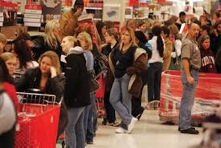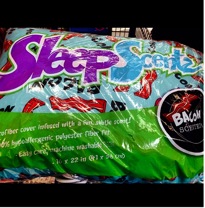By Laurent Haccoun, Trishna Mahtani, and Kimberly Mac Tavish
This Thanksgiving, ask yourself before heading straight from the dinner table to the Black Friday deals how much the discounts are truly worth? Would you be willing to stake your life on a 40% savings for a big screen TV? Black Friday shopping has led to many deaths and injuries including a 2008 tragedy that involved a part-time worker who was trampled to death by a mob of customers at a Long Island Wal-Mart. Wal-Mart embraces the notion of consumerism being a competitive sport. Consumers are encouraged to emulate the buying behaviors of those who have more than them through Wal-Mart selection of product offerings, its pricing strategies and the design layout of its stores.
Black Friday shopping has led to many deaths and injuries including a 2008 tragedy that involved a part-time worker who was trampled to death by a mob of customers at a Long Island Wal-Mart. Wal-Mart embraces the notion of consumerism being a competitive sport. Consumers are encouraged to emulate the buying behaviors of those who have more than them through Wal-Mart selection of product offerings, its pricing strategies and the design layout of its stores.
Wal-Mart literally creates demand by promoting products that customers don’t need and didn’t know about prior to entering the store. For example, in 1998 Wal-Mart began to sell a gallon of Vlasic’s jar of pickles for $2.97 [1]. In this case, customers were not able to eat all the pickles before the mold set in, and would end up throwing most of them out [2]. Wal-Mart has gotten its customers to buy more from it through its expansion of fresh product offerings which everyone needs. However, these items are not high margin. Therefore, Wal-Mart needs its customers to buy  what they don’t need: jellybean flavored milk, pickle flavored popsicles, and apple pie flavored juice. Other must-have items include a bacon-scented pillow, an alligator toilet paper holder and decorative gangsta gnomes [3]. Wal-Mart plays on the psychological needs of consumers and promotes the idea that that the more you have, the more you are worth [4]. Even President Carter warned us of this impending danger: Consumers act to fulfill a psychological need. The more you buy, the happier you will be. But this happiness that consumption buys is only temporary. So in order to continue to feel happy, consumers need to continue to buy from Wal-Mart. Score: Wal-Mart 1. Consumer 0.
what they don’t need: jellybean flavored milk, pickle flavored popsicles, and apple pie flavored juice. Other must-have items include a bacon-scented pillow, an alligator toilet paper holder and decorative gangsta gnomes [3]. Wal-Mart plays on the psychological needs of consumers and promotes the idea that that the more you have, the more you are worth [4]. Even President Carter warned us of this impending danger: Consumers act to fulfill a psychological need. The more you buy, the happier you will be. But this happiness that consumption buys is only temporary. So in order to continue to feel happy, consumers need to continue to buy from Wal-Mart. Score: Wal-Mart 1. Consumer 0.
Wal-Mart’s aggressive pricing allows consumers to save on individual items; however, the prices are so low that spontaneous consumption is seemingly inevitable (i.e. “I didn’t know I wanted this, but now I MUST have it!”) and the savings are just plowed back into more items for budget-busting baskets. In fact, Wal-Mart has made shopping a guiltless pleasure for customers knowing that the ‘Every Day Low Prices’ in conjunction with the Wal-mart ‘Saving Catcher’ (an app comparing Wal-Mart prices against any local ad which reimburses customers for any difference) will spare them from any excess spending. Guilt, be gone! “Shopping at Wal-Mart means paying less for something than you otherwise have to. You can buy exactly the same product and spend less and you know it…..Wal-Mart feels good. You can feel proud of yourself. Shopping at Wal-Mart is, quite literally, a virtue.” [5]. In fact, it is such a virtue that despite a 2012 consumer report survey ranking it amongst the least favorite grocers, Wal-Mart was actually the number one grocer at the time [6,7]. Oh, the sacrifices we make! Meantime, the Wal-Mart mobile app letting customers know of nearby Wal-Marts and the local deals actually increased spending by 40% [8]. Ultimately it is clear that Wal-Mart will take any excuse to discount further to stimulate more and more shopping. “It used to be called Black Friday, then it became Thursday, now it’s a week long,” says Wal-Mart US Chief merchant Duncan MacNaughton. “Maybe we should just call it November” [9].
Like all savvy merchandisers, Wal-Mart uses all the tricks to make sure it exposes the greatest number of products to the greatest number of customers with the ultimate prize of getting as many as possible to the back of the store. From reflective surfaces which slow customers down to mid-aisle breaks designed to counteract the ‘boomerang’ effect of a customer turning back half-way down an aisle after they have pick up an item – these are all tactics to guide the customer through more and more of the store [10]. It’s no mistake that the dairy cases are against the back wall; this logistical coup is designed to have hurried shoppers pass by the cereal aisle, the coffee aisle, etc. Wal-Mart have been especially skilled at perfecting what is called ‘action alley – prime selling space where they can use large displays or pallets to reduce restocking costs and highlight that week’s deals [11].  But for some directionally-challenged shoppers, this bigger and bigger philosophy has led to challenges (and Wal-Mart’s worst nightmare!) – they can’t find the products they are looking for, resulting in about 20% of lost retail sales. Fortunately, in today’s technology driven world there’s an app for that too. Wal-Mart’s indoor navigation app lets customers locate a product and aisle [12]. What a great way to make sure the must-have items and associated savings are not lost on us in the immensity of the supercenter [13]. In the first two weeks following the app launch, it saw 15% of page views from in-store customers. In the end, Wal-Mart will make sure that not only do you find the item you are looking for, but that you leave with a few extras as well.
But for some directionally-challenged shoppers, this bigger and bigger philosophy has led to challenges (and Wal-Mart’s worst nightmare!) – they can’t find the products they are looking for, resulting in about 20% of lost retail sales. Fortunately, in today’s technology driven world there’s an app for that too. Wal-Mart’s indoor navigation app lets customers locate a product and aisle [12]. What a great way to make sure the must-have items and associated savings are not lost on us in the immensity of the supercenter [13]. In the first two weeks following the app launch, it saw 15% of page views from in-store customers. In the end, Wal-Mart will make sure that not only do you find the item you are looking for, but that you leave with a few extras as well.
Many critics of this perspective, including Wal-Mart founder Sam Walton, would argue that Wal-Mart’s low prices translate directly into savings for the customer [14]. For a typical family of four, on average this amounts to an annual savings of $900 on groceries alone. However, since the average family in fact only saves about 1% of its income (about $500 per year), the $900 Wal-Mart grocery savings do not translate into actual savings [15]. It’s more likely that the difference in these savings goes right back into Wal-Mart as customers fall prey to the many techniques designed to have them spend more.
So, as we come upon another “Black Friday” shopping frenzy, which Wal-Mart has evolved into “Black Week”, consumers have to ask themselves what they really need and get their resolve ready. Because as we’ve seen, just your average resolve is no match for the tricks that Wal-Mart has up its sleeve.
Photo sources: http://centsibletreasures.biz/?p=502; https://storify.com/qma4/walmart-store-layouts
References
[1] Charles Fishman, The Wal-Mart Effect – How the World’s Most Powerful Company Really Works – and How It’s Transforming the American Economy, Penguin Books: 2011, 80.
[2] Charles Fishman, The Wal-Mart Effect – How the World’s Most Powerful Company Really Works – and How It’s Transforming the American Economy, Penguin Books: 2011, 81.
[3] Brian Galindo, “31 Products You Won’t Believe You Can Actually Buy At Walmart,” Buzzfeed.com, 30 June, 2014. http://www.buzzfeed.com/briangalindo/oh-walmart-never-stop (Accessed November 12, 2014)
[4] Juliet Schor, “The New Politics of Consumption – Why Americans want so much more than they need,” BostonReview.net, Summer 1999. http://new.bostonreview.net/BR24.3/schor.html (Accessed November 12, 2014)
[5] Charles Fishman, The Wal-Mart Effect – How the World’s Most Powerful Company Really Works – and How It’s Transforming the American Economy, Penguin Books: 2011, 218.
[6] Allison Linn, “We love Whole Foods but shop at Wal-Mart,” Today.com, 4 April, 2012 http://www.today.com/money/we-love-whole-foods-shop-wal-mart-649289 (Accessed November 13, 2014)
[7] Allison Linn, “Best and worst supermarkets — shoppers tell all,” Today.com, 3 April, 2012 http://www.today.com/money/best-worst-supermarkets-shoppers-tell-all-636185?franchiseSlug=todaymoneymain (Accessed November 13, 2014)
[8] Lauren Johnson, “Walmart app users spend 40pc more than average shopper,” Mobilecommercedaily.com, 26 September 2013. http://www.mobilecommercedaily.com/walmart-app-users-spend-40-percent-more-than-average-shopper (Accessed November 13, 2014)
[9] Yoel Minkoff, “Wal-Mart announces ‘Black Week’,” Seekingalpha.com, 12 November 2014. http://seekingalpha.com/news/2117425-wal-mart-announces-black-week (Accessed November 13, 2014)
[10] Paco Underhill, “Shoppers Move Like People,” Why We Buy- The Science of Shopping, Simon & Schuster Paperbacks, pages 78, 84.
[11] Charles Fishman, The Wal-Mart Effect – How the World’s Most Powerful Company Really Works – and How It’s Transforming the American Economy, Penguin Books: 2011, 67.
[12] Roger Yu, “Retailers introduce indoor navigation in apps,” usatoday.com. 28 August, 2012. http://usatoday30.usatoday.com/tech/news/story/2012-08-27/big-retailer-mobile-apps/57381210/1 (Accessed November 13, 2014)
[13] Walmart.com. http://www.walmart.com/cp/Walmart-Mobile-App/1087865 (Accessed November 13, 2014)
[14] Sam Walton with John Huey, Sam Walton Made in America, My Story, Bantam Books: 1993, 12-13.
[15] Charles Fishman, The Wal-Mart Effect – How the World’s Most Powerful Company Really Works – and How It’s Transforming the American Economy, Penguin Books: 2011, 200-205.